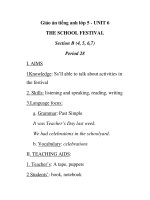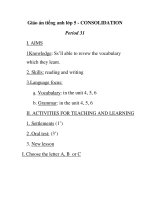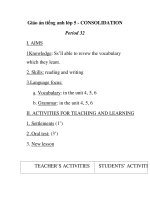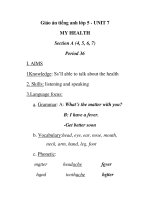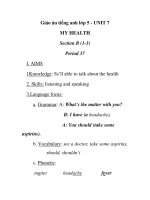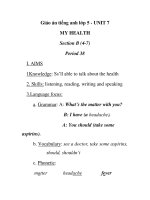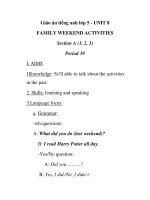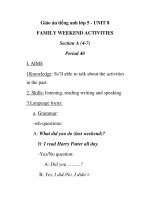giao an tieng anh lop 5 20162017 Unit 1 2 3
Bạn đang xem bản rút gọn của tài liệu. Xem và tải ngay bản đầy đủ của tài liệu tại đây (145.51 KB, 21 trang )
<span class='text_page_counter'>(1)</span>Week: Period:. Date of preparing: Date of teaching: UNIT 1: WHAT’S YOUR ADDRESS? Lesson 1: (1,2,3). I. Objectives: By the end of the lesson, Ss will be able to: - Ask and answer about someone’s address - Develop Ss’ speaking and listening skills II. Language focus: Pattern: What’s your address? Voc.: address, street, flat, tower, road, … III. Teaching aids: Pictures, textbook, projector … III. Procedure: Teacher’s and Ss’ activities Content A. Warm-up: - Chatting and greeting together B. Presentation: * Vocabulary: address, flat, stress, tower, village, road - T follows the steps of presenting new words. - Ss follow T’s instructions * Dialogue: 1. Look, listen and repeat: - T shows the pictures on the bb and play the CD - Ss look and repeat the dialogues 3 times - T calls on some Ss to read - Ss work in pairs in 2 minutes to practice - Some pairs read aloud - T corrects pronunciation C. Practice: 2. Point and say: - T gives out the pattern and explain how What’s your address? to use It’s ……………. - Ss copy the pattern - T introduces the picture cues and guides Ss how to ask and answer using the cues - Ss work in pairs to practice - Get feedback - T ask some pairs to read aloud D. Production: 3. Let’s talk: - T asks some pairs to stand up and S1: What’s your address? practice speaking basing on their real S2: It’s 32 Nguyen Thong Street information - Other Ss observe and say their comments E. Homelink: - T tells the homework and Ss take notes - Learn new words and practice the.
<span class='text_page_counter'>(2)</span> structures - Prepare for new lesson: Lesson 1: 4,5,6 Week: Period:. Date of preparing: Date of teaching: UNIT 1: WHAT’S YOUR ADDRESS? Lesson 1: (4,5,6). I. Objectives: By the end of the lesson, Ss will be able to: - Ask and answer about someone’s address - Develop Ss’ writing and listening skills II. Language focus: Pattern: What’s your address? Voc.: address, street, flat, tower, road, … III. Teaching aids: Pictures, textbook, projecter … III. Procedure: Teacher’s and Ss’ activities Content A. Warm-up: - Chatting and greeting together B. Presentation: * Vocabulary: - T recalls the vocabulary address, flat, stress, tower, village, road - Ss follow T’s instructions * Dialogue: - Some pairs ask and answer about their addresses S1: What’s your address? - T corrects pronunciation S2: It’s ……………... C. Practice: - Ss scan the dialogue in which there are some gaps. - T elicits the dialogue, play the CD several times - Ss listen and fill the gaps - Some Ss call out the answers - Other give comments. 4. Listen and comlete:. - T tells the context and completes the sentences - Give Ss a few seconds to read and look at the pictures - Check comprehension and elicit the words to fill the gaps - Ask Ss do the task - Check their answers - Do choral and individual repetition. 5. Read and complete: Key: 1. from 2. lives 3. address 4. Street. Key: 1. 208 2. 321 3. White Street 4. second floor.
<span class='text_page_counter'>(3)</span> D. Production: - T guides Ss to sing the song - Ss listen and sing along E. Homelink: - T tells the homework and Ss take notes. Week: Period:. 6. Let’s sing What’s your address? - Learn new words and practice the structures - Prepare for new lesson: Lesson 2: 1,2,3. Date of preparing: Date of teaching: UNIT 1: WHAT’S YOUR ADDRESS? Lesson 2: (1,2,3). I. Objectives: By the end of the lesson, Ss will be able to: - Ask and answer about what a village/ town/ city is like - Develop Ss’ speaking and reading skills II. Language focus: Pattern: What’s the… like? – It’s … Voc.: like, quiet, crowded, pretty, hometown, small, beautiful, mountain, think, busy, island… III. Teaching aids: Pictures, textbook, projecter … III. Procedure: Teacher’s and Ss’ activities Content A. Warm-up: - Sing the song “The wheel on the bus” B. Presentation: * Vocabulary: like, quiet, crowded, pretty, hometown, - T follows the steps of presenting new small, beautiful, mountain, think, busy, words. island - Ss follow T’s instructions * Dialogue: 1. Look, listen and repeat: - T shows the pictures on the bb and play the CD - Ss look and repeat the dialogues 3 times - T calls on some Ss to read - Ss work in pairs in 2 minutes to practice - Some pairs read aloud - T corrects pronunciation C. Practice: 2. Point and say: - T gives out the pattern and explain how What’s the … like? to use It’s ……………. - Ss copy the pattern - T introduces the picture cues and guides Ss how to ask and answer using the cues - Ss work in pairs to practice - Get feedback.
<span class='text_page_counter'>(4)</span> - T ask some pairs to read aloud D. Production: - T asks some pairs to stand up and practice speaking basing on their real information - Other Ss observe and say their comments E. Homelink: - T tells the homework and Ss take notes. Week: Period:. 3. Let’s talk: S1: What’s your city like? S2: It’s quiet and beautiful.. - Learn new words and practice the structures - Prepare for new lesson: Lesson 2: 4,5,6. Date of preparing: Date of teaching: UNIT 1: WHAT’S YOUR ADDRESS? Lesson 2: (4,5,6). I. Objectives: By the end of the lesson, Ss will be able to: - Ask and answer about what a village/ town/ city is like - Develop Ss’ speaking and reading skills II. Language focus: Pattern: What’s the… like? – It’s … Voc.: like, quiet, crowded, pretty, hometown, small, beautiful, mountain, think, busy, island… III. Teaching aids: Pictures, textbook, projecter, CD … III. Procedure: Teacher’s and Ss’ activities Content A. Warm-up: - Play “Guessing game” mountain, small, crowded, busy, quiet, city, island, hometown B. Presentation: * Vocabulary: - T recalls the vocabulary like, quiet, crowded, pretty, hometown, - Ss follow T’s instructions small, beautiful, mountain, think, busy, * Dialogue: island - Some pairs ask and answer about their hometown - T corrects pronunciation S1: What’s your city like? S2: It’s quiet and beautiful. C. Practice: - T shows the gap-fill on and guides . - T elicits the dialogue, play the CD several times - Ss listen and fill the gaps by circling - 4 Ss go to the board and circle the. 4. Listen and circle: Key: 1. a 2. b 3. b.
<span class='text_page_counter'>(5)</span> answers - Others give comments. 4. a. - Have Ss read the instruction - T asks Ss to do the task in 5 minutes. T goes round for help if necessary - 2 Ss write on the board - Correct mistakes - T emphasizes some main points - Do choral and individual repetition D. Production: - T guides Ss to play the game - Ss listen and play E. Homelink: - T tells the homework and Ss take notes. 5. Write about you:. Week: Period:. Ss’ writing. 6. Let’s play Find someone who - Learn new words and practice the structures - Prepare for new lesson: Lesson 3: 1,2,3. Date of preparing: Date of teaching: UNIT 1: WHAT’S YOUR ADDRESS? Lesson 3: (1,2,3). I. Objectives: By the end of the lesson, Ss will be able to: - Listen and repeat words, listen and circle - Do the chant “Where do you live?” - Develop Ss’ reading and listening skills II. Language focus: Pattern: Where do you live? – I live …. III. Teaching aids: Pictures, textbook, projecter … III. Procedure: Teacher’s and Ss’ activities A. Warm-up: - Play a game Bingo B. Presentation: - T recalls vocabulary - Ss follow T’s instruction - T shows the words and models the stress - Ask Ss to repeat the words. Content. 1. Listen and repeat: ‘city Linda lives in a ‘city. ‘village My best friend lives in a ‘village. ‘moutains I live in the ‘mountain. ‘tower He lives in a tall and quiet ‘tower..
<span class='text_page_counter'>(6)</span> C. Practice: - T shows the gap-fill on and guides . - T elicits the sentences, play the CD several times - Ss listen and fill the gaps by circling - 3 Ss go to the board and circle the answers - Others give comments - Practice reading D. Production: - T shows the chant on the board, plays the CD 3 times and guides Ss how to do the chant sentence by sentence - Ss follow T’s instruction - The whole class practice - Some Ss do chanting in front of the class. E. Homelink: - T tells the homework and Ss take notes. Week: Period:. 2. Listen and circle a or b. Then say the sentences aloud.: Key: 1. b 2. a 3. a. 3. Let’s chant: Where do you live? Where do you live? I live in Quang Trung Street. Where do you live? I live in Green Avenue. Where do you live? I live in Green Tower. What’s Green Tower like? It’s tall and quiet. What’s your flat like? It’s big and pretty. - Practice reading the words and the chant - Do exercise in Work book. - Prepare for new lesson: Lesson 3: 4,5,6. Date of preparing: Date of teaching: UNIT 1: WHAT’S YOUR ADDRESS? Lesson 3: (4,5,6). I. Objectives: By the end of the lesson, Ss will be able to: - Read and answer about one’s hometown - Review the lesson - Develop Ss’ reading and writing skills II. Language focus: Pattern: Where do you live? – I live …. III. Teaching aids: Pictures, textbook, projecter … III. Procedure: Teacher’s and Ss’ activities Content A. Warm-up: - Do the chant “ Where do you live?” B. Presentation: - T teaches some key words in the text.
<span class='text_page_counter'>(7)</span> - Ss follow T’s instruction and take notes - Check vocabualary C. Practice: - T elicits the text - Ask some Ss to read the text - T corrects pronunciation - Ss work in pairs to discuss the answers - Get feedback, some Ss tick Y or N on the board. The others give comments. - T shows correct answers. 4. Read and tick Yes (Y) or No (N): Answer key: 1. N 2. Y 3. N 4. Y 5. Y 5. Write about your friend:. - T explains the task and the questions - Ss work individually to write about their friends - T goes round for help - 2 Ss write on the board - T and other Ss give comments. 1. What’s his/her name? 2. Where is he/she from? 3. What’s his/ her address? 4. Who does he/she live with? 5. What’s his/her home like? 6. Does he/she like his/ her hometown? Why/Why not?. D. Production: - T explains the the task - Ss draw a house in their paper E. Homelink: - T tells the homework and Ss take notes. 6. Project: Draw a house and write its address. Week: Period:. - Do task 7 page 11: colour the stars to evaluate your skills - Practice reading and writing at home - Do exercise in Work book. - Prepare for new lesson: Unit 2- Lesson 1: 1,2,3. Date of preparing: Date of teaching: UNIT 2: I ALWAYS GET UP EARLY. HOW ABOUT YOU? Lesson 1: (1,2,3) I. Objectives: By the end of the lesson, Ss will be able to: - Ask and answer about someone’s daily routine - Develop Ss’ speaking and listening skills II. Language focus: Pattern: What do you do ……………? – I always/ usually/ often/ sometimes/ never ….. Voc.: get up early, brush my teeth, do morning exercise, cook dinner, watch TV, talk with friends online, do homework, have a big breakfast III. Teaching aids: Pictures, textbook, projecter … III. Procedure: Teacher’s and Ss’ activities Content.
<span class='text_page_counter'>(8)</span> A. Warm-up: - Sing the song B. Presentation: * Vocabulary: - T follows the steps of presenting new words. - Ss follow T’s instructions * Dialogue: - T shows the pictures on the bb and play the CD - Ss look and repeat the dialogues 3 times - T calls on some Ss to read - Ss work in pairs in 2 minutes to practice - Some pairs read aloud - T corrects pronunciation - T emphasize the averbs of frequency in the dialogue C. Practice: - T gives out the pattern and explain how to use - Ss copy the pattern - T introduces the picture cues and guides Ss how to ask and answer using the cues - Ss work in pairs to practice - Get feedback - T ask some pairs to read aloud D. Production: - T asks some pairs to stand up and practice speaking basing on their real information - Other Ss observe and say their comments E. Homelink: - T tells the homework and Ss take notes. Week: Period:. The wheel on the bus Vocabulary - get up early - have a big breakfast - talk with friends online - do homework - brush my teeth - do morning exercise - cook dinner - watch TV 1. Look, listen and repeat: always, usually, often, sometimes, never 2. Point and say: What do you do ………….? – I always/ usually/ often/ sometimes/ never ….. Ex: a. morning/ always brush my teeth S1: What do you do in the morning? S2: I always brush my teeth. 3. Let’s talk: S1: What’s do you do in the morning/ afternoon/ evening? S2: – I always/ usually/ often/ sometimes/ never ….. - Learn new words and practice the structures - Prepare for new lesson: Unit2 - Lesson 1: 4,5,6. Date of preparing: Date of teaching: UNIT 2: I ALWAYS GET UP EARLY. HOW ABOUT YOU? Lesson 1: (4,5,6) I. Objectives: By the end of the lesson, Ss will be able to: - Ask and answer about someone’s daily routine - Develop Ss’ writing and listening skills.
<span class='text_page_counter'>(9)</span> II. Language focus: Pattern: What’s do you do in the morning/ afternoon/ evening? – I always/ usually/ often/ sometimes/ never ….. Voc.: get up early, have a big breakfast, talk with friends online, do homework, brush my teeth, do morning exercise, cook dinner, watch TV III. Teaching aids: Pictures, textbook, projecter … III. Procedure: Teacher’s and Ss’ activities Content A. Warm-up: - Chatting and greeting together B. Presentation: * Vocabulary: - get up early - T recalls the vocabulary - have a big breakfast - Ss follow T’s instructions - talk with friends online - do homework - brush my teeth - do morning exercise - cook dinner - watch TV * Dialogue: - Some pairs ask and answer about their addresses - T corrects pronunciation. S1: What’s do you do in the morning/ afternoon/ evening? S2: – I always/ usually/ often/ sometimes/ never …... C. Practice: - Ss scan the dialogue in which there are some gaps. - T elicits the dialogue, play the CD several times - Ss listen and fill the gaps - Some Ss call out the answers - Other give comments. 4. Listen and tick:. - T tells the context and completes the sentences - Give Ss a few seconds to read and look at the pictures - Check comprehension and elicit the words to fill the gaps - Ask Ss do the task - Check their answers - Do choral and individual repetition D. Production: - T guides Ss to sing the song - Ss listen and sing along. 5. Read and complete: Key: 1. do 2. usually 3. play 4. TV 5. like. Key: 1. c 2. b 3. b 4. a. 6. Let’s sing This is the way we do things.
<span class='text_page_counter'>(10)</span> E. Homelink: - T tells the homework and Ss take notes. Week: Period:. - Learn new words and practice the structures - Prepare for new lesson: Unit 2 Lesson 2: 1,2,3. Date of preparing: Date of teaching: UNIT 2: I ALWAYS GET UP EARLY. HOW ABOUT YOU? Lesson 2: (1,2,3) I. Objectives: By the end of the lesson, Ss will be able to: - Ask and answer about frequency - Develop Ss’ speaking and reading skills II. Language focus: Pattern: How often do you….? – I………… every day/ once/ twice a week/ month Voc.: partner, project, look for, surf, information, get dressed, once, twice III. Teaching aids: Pictures, textbook, projecter … III. Procedure: Teacher’s and Ss’ activities Content A. Warm-up: - Sing the song “This is the way we do things” B. Presentation: * Vocabulary: partner, project, look for, surf, - T follows the steps of presenting new information, get dressed, once, twice words. - Ss follow T’s instructions * Dialogue: 1. Look, listen and repeat: - T shows the pictures on the bb and play the CD - Ss look and repeat the dialogues 3 times - T calls on some Ss to read - Ss work in pairs in 2 minutes to practice - Some pairs read aloud - T corrects pronunciation C. Practice: 2. Point and say: - T gives out the pattern and explain how How often do you….? to use – I………… every day/ once/ twice a - Ss copy the pattern week/ month - T introduces the picture cues and guides Ss how to ask and answer using the cues - Ss work in pairs to practice - Get feedback - T ask some pairs to read aloud D. Production: 3. Let’s talk: - T asks some pairs to stand up and S1: What’s do you do in the morning/.
<span class='text_page_counter'>(11)</span> practice speaking basing on their real information - Other Ss observe and say their comments E. Homelink: - T tells the homework and Ss take notes. afternoon/ evening? S2: – I always/ usually/ often/ sometimes/ never ….. S1: How often do you….? S2: I………… every day/ once/ twice a week/ month - Learn new words and practice the structures - Prepare for new lesson: Unit 2 Lesson 2: 4,5,6. Week: Period:. Date of preparing: Date of teaching: UNIT 2: I ALWAYS GET UP EARLY. HOW ABOUT YOU? Lesson 2: (4,5,6) I. Objectives: By the end of the lesson, Ss will be able to: - Listen and number the pictures - Write about someone’s daily routine and do crossword II. Language focus: Pattern: How often do you….? – I………… every day/ once/ twice a week/ month Voc.: partner, project, look for, surf, information, get dressed, once, twice III. Teaching aids: Pictures, textbook, projecter, CD … III. Procedure: Teacher’s and Ss’ activities Content A. Warm-up: - Play “Slap the board” partner, project, look for, surf, information, get dressed, once, twice B. Presentation: * Dialogue: - Some pairs ask and answer about their hometown - T corrects pronunciation C. Practice: - T shows the gap-fill on and guides . - T elicits the dialogue, play the CD several times - Ss listen and number the pictures - 4 Ss go to the board and write the answers - Others give comments. S1: What’s do you do in the morning/ afternoon/ evening? S2: – I always/ usually/ often/ sometimes/ never ….. S1: How often do you….? S2: I………… every day/ once/ twice a week/ month. 4. Listen and number: Key: 1. b 2. c 3. d 4. a.
<span class='text_page_counter'>(12)</span> - Have Ss read the instruction - T asks Ss to do the task in 5 minutes. T goes round for help if necessary - 2 Ss write on the board - Correct mistakes - T emphasizes some main points - Do choral and individual repetition D. Production: - T guides Ss to play the game - Ss listen and play E. Homelink: - T tells the homework and Ss take notes. 5. Write about you: 1. What do you do in the morning? 2. What do you do in the afternoon? 3. Do you go to bed early in the evening? 4. How often do you watch TV? 6. Let’s play Crossword puzzle - Learn new words and practice the structures - Prepare for new lesson: Unit 2 Lesson 3: 1,2,3. Week: Period:. Date of preparing: Date of teaching: UNIT 2: I ALWAYS GET UP EARLY. HOW ABOUT YOU? Lesson 3: (1,2,3) I. Objectives: By the end of the lesson, Ss will be able to: - Listen and repeat words, listen and circle - Do the chant “What do you do in the morning?” - Develop Ss’ reading and listening skills II. Language focus: Pattern: Where do you live? – I live …. What’s do you do in the morning/ afternoon/ evening?– I always/ usually/ often/ sometimes/ never ….. III. Teaching aids: Pictures, textbook, projecter … III. Procedure: Teacher’s and Ss’ activities Content A. Warm-up: - Play a game Bingo B. Presentation: - T recalls vocabulary - Ss follow T’s instruction - T shows the words and models the stress - Ask Ss to repeat the words. 1. Listen and repeat: ‘always I always get up early. ‘usually I usually have dinner at home. ‘often I often go to bed early. ‘sometimes I sometimes go swimming on Sundays.. C. Practice: - T shows the gap-fill on and guides . - T elicits the sentences, play the CD. 2. Listen and circle a or b. Then say the sentences aloud.: Key:.
<span class='text_page_counter'>(13)</span> several times - Ss listen and fill the gaps by circling - 3 Ss go to the board and circle the answers - Others give comments - Practice reading D. Production: - T shows the chant on the board, plays the CD 3 times and guides Ss how to do the chant sentence by sentence - Ss follow T’s instruction - The whole class practice - Some Ss do chanting in front of the class. E. Homelink: - T tells the homework and Ss take notes. Week: Period:. 1. a 2. b 3. a 4. b 3. Let’s chant: What do you do in the morning? What do you do in the morning? I always brush my teeth. What do you do after getting up? I usually go to school. How often do you go to the library? I go there once a week. How often do you play computer games? I play them every week! - Practice reading the words and the chant - Do exercise in Work book. - Prepare for new lesson: Unit 2 Lesson 3: 4,5,6. Date of preparing: Date of teaching: UNIT 2: I ALWAYS GET UP EARLY. HOW ABOUT YOU? Lesson 3: (4,5,6) I. Objectives: By the end of the lesson, Ss will be able to: - Read and answer about one’s hometown - Review the lesson - Develop Ss’ reading and writing skills II. Language focus: Pattern: Where do you live? – I live …. III. Teaching aids: Pictures, textbook, projecter … III. Procedure: Teacher’s and Ss’ activities Content A. Warm-up: - Do the chant “What do you do in the morning?” B. Presentation: - T teaches some key words in the text - Ss follow T’s instruction and take notes - Check vocabualary C. Practice: 4. Read and answer: - T elicits the text Answer key:.
<span class='text_page_counter'>(14)</span> - Ask some Ss to read the text - T corrects pronunciation - Ss work in pairs to discuss the answers - Get feedback, some Ss tick Y or N on the board. The others give comments. - T shows correct answers. 6. She gets up early and usually goes jogging in the morning. 7. After school, she usually does her homework. 8. She watches English for Kids once a week. 9. She goes shopping once a week.. - T explains the task and gives some clues - Ss work individually to write about their friends - T goes round for help - 2 Ss write on the board - T and other Ss give comments D. Production: - T explains the the task - Ss draw a house in their paper. 5. Write about your day: My name is ………… In the morning, I always ……………….. In the afternoon, I usually ……………… In the evening, I ……………….. I …………………………………… 6. Project: Interview two of your classmates about their daily routines.. E. Homelink: - T tells the homework and Ss take notes. - Do task 7 page 17: colour the stars to evaluate your skills - Practice reading and writing at home - Do exercise in Work book. - Prepare for new lesson: Unit 2- Lesson 1: 1,2,3. Week: Period:. Date of preparing: Date of teaching: UNIT 3: WHERE DID YOU GO ON HOLIDAY? Lesson 1: (1,2,3). I. Objectives: By the end of the lesson, Ss will be able to: - Ask and answer questions about past holidays - Develop Ss’ speaking and listening skills II. Language focus: Pattern: Where did you go on holiday? – I went to ….. Voc.: island, ancient, town, imperial city III. Teaching aids: Pictures, textbook, projecter … III. Procedure: Teacher’s and Ss’ activities Content A. Warm-up: - Sing the song This is the way we do things B. Presentation: * Vocabulary: Vocabulary - T follows the steps of presenting new - island words. - ancient - Ss follow T’s instructions - town.
<span class='text_page_counter'>(15)</span> - imperial city * Dialogue: 1. Look, listen and repeat: page 18 - T shows the pictures on the bb and play the CD - Ss look and repeat the dialogues 3 times - T calls on some Ss to read - Ss work in pairs in 2 minutes to practice - Some pairs read aloud - T corrects pronunciation - T emphasize the past forms Be (was / were) What was the trip like? – It was really nice. C. Practice: 2. Point and say: - T gives out the pattern and explain how Where did you go on holiday? – I went to to use ….. - Ss copy the pattern Ex: - T introduces the picture cues and guides a. Ha Long Bay Ss how to ask and answer using the cues S1: Where did you go on holiday? - Ss work in pairs to practice S2: I went to Ha Long Bay. - Get feedback - T ask some pairs to read aloud D. Production: 3. Let’s talk: - T asks some pairs to stand up and S1: Where were you on holiday? practice speaking basing on their real S2: I was …………. information S1: Where did you go? - Other Ss observe and say their S2: I went to ………… comments S1: What was the trip like? S2: It was ……………. E. Homelink: - T tells the homework and Ss take notes. Week: Period:. - Learn new words and practice the structures - Prepare for new lesson: Unit2 - Lesson 1: 4,5,6. Date of preparing: Date of teaching: UNIT 3: WHERE DID YOU GO ON HOLIDAY? Lesson 1: (4,5,6). I. Objectives: By the end of the lesson, Ss will be able to: - Ask and answer questions about past holidays - Develop Ss’ writing and listening skills II. Language focus: Pattern: Where did you go on holiday? – I went to ….. Voc.: island, ancient, town, imperial city III. Teaching aids:.
<span class='text_page_counter'>(16)</span> Pictures, textbook, projecter … III. Procedure: Teacher’s and Ss’ activities A. Warm-up: - Chatting and greeting together B. Presentation: * Vocabulary: - T recalls the vocabulary - Ss follow T’s instructions. Content. - island - ancient - town - imperial city. * Dialogue: - Some pairs ask and answer about their holidays - T corrects pronunciation. S1: Where were you on holiday? S2: I was …………. S1: Where did you go? S2: I went to ………… S1: What was the trip like? S2: It was ……………. S1: Where were you on holiday? S2: I was …………. S1: Where did you go? S2: I went to ………… S1: What was the trip like? S2: It was …………….. C. Practice: - Ss scan the pictures and guess where they went on their holidays - T elicits the dialogue, play the CD several times - Ss listen and match - Some Ss call out the answers - Other give comments. 4. Listen and match:. - T tells the context and completes the sentences - Give Ss a few seconds to read - Check comprehension and elicit the words to fill the gaps - Ask Ss do the task - Check their answers - Do choral and individual repetition D. Production: - T guides Ss to play a game - Ss follow T’s instructions E. Homelink: - T tells the homework and Ss take notes. 5. Read and match: Key: 1. c 2. d 3. a 4. e 5. b. Key: 1. c 2. b 3. d 4. a. 6. Let’s play Find someone who - Learn new words and practice the structures.
<span class='text_page_counter'>(17)</span> - Prepare for new lesson: Unit 3 Lesson 2: 1,2,3 Week: Period:. Date of preparing: Date of teaching: UNIT 3: WHERE DID YOU GO ON HOLIDAY? Lesson 2: (1,2,3). I. Objectives: By the end of the lesson, Ss will be able to: - Ask and answer questions about means of transport - Develop Ss’ speaking and reading skills II. Language focus: Pattern: How did you get there? – I went by ……….. Voc.: underground, train, coach, taxi, motorbike III. Teaching aids: Pictures, textbook, projecter … III. Procedure: Teacher’s and Ss’ activities Content A. Warm-up: Guessing - Play a game What is it behind the picture? 1. motorbike 2. taxi 3. bike / bicycle 4. plane B. Presentation: * Vocabulary: Vocabulary - T follows the steps of presenting new - underground words. - train - Ss follow T’s instructions - coach - motorbike * Dialogue: - T shows the pictures on the bb and play the CD - Ss look and repeat the dialogues 3 times - T calls on some Ss to read - Ss work in pairs in 2 minutes to practice - Some pairs read aloud - T corrects pronunciation C. Practice: - T gives out the pattern and explain how to use - Ss copy the pattern - T introduces the picture cues and guides Ss how to ask and answer using the cues - Ss work in pairs to practice. 1. Look, listen and repeat:. 2. Point and say: How did you get there? – I went by ……….. Ex: How did you get there? – I went by train..
<span class='text_page_counter'>(18)</span> - Get feedback - T ask some pairs to read aloud D. Production: - T asks some pairs to stand up and practice speaking basing on their real information - Other Ss observe and say their comments E. Homelink: - T tells the homework and Ss take notes. Week: Period:. 3. Let’s talk: S1: Where were you on holiday? / Where did you go? S2: I was ………. / I went to ………. S1: How did you get there? S2: I went by ……………. - Learn new words and practice the structures - Prepare for new lesson: Unit 3 Lesson 2: 4,5,6. Date of preparing: Date of teaching: UNIT 3: WHERE DID YOU GO ON HOLIDAY? Lesson 2: (4,5,6). I. Objectives: By the end of the lesson, Ss will be able to: - Ask and answer questions about means of transport - Write about someone’s last holiday and practice singing II. Language focus: Pattern: How did you get there? – I went by ……….. Voc.: underground, train, coach, taxi, motorbike III. Teaching aids: Pictures, textbook, projecter, CD … III. Procedure: Teacher’s and Ss’ activities Content A. Warm-up: - Play “Slap the board” underground, train, coach, taxi, motorbike B. Presentation: * Dialogue: S1: Where were you on holiday? / Where - Some pairs ask and answer about their did you go? hometown S2: I was ………. / I went to ………. - T corrects pronunciation S1: How did you get there? S2: I went by ……………. C. Practice: 4. Listen and write: - T shows the gap-fill on and guides . - T elicits the dialogue, play the CD Key: several times 1. motorbike - Ss listen and number the pictures 2. train - 4 Ss go to the board and write the 3. taxi answers 4. plane - Others give comments.
<span class='text_page_counter'>(19)</span> - Have Ss read the instruction - T asks Ss to do the task in 5 minutes. T goes round for help if necessary - 2 Ss write on the board - Correct mistakes - T emphasizes some main points - Do choral and individual repetition D. Production: - T guides Ss to sing - Ss listen and sing along E. Homelink: - T tells the homework and Ss take notes. Week: Period:. 5. Write about your last holiday: 1. Where did you go on holiday? 2. How did you get there? 3. What did you do there? 4. Did you enjoy your trip? 6. Let’s sing How did you get there? - Learn new words and practice the structures - Prepare for new lesson: Unit 3 Lesson 3: 1,2,3. Date of preparing: Date of teaching: UNIT 3: WHERE DID YOU GO ON HOLIDAY? Lesson 3: (1,2,3). I. Objectives: By the end of the lesson, Ss will be able to: - Listen and repeat words, listen and circle - Do the chant “Where did you go?” - Develop Ss’ reading and listening skills II. Language focus: Pattern: Where do you live? – I live …. What’s do you do in the morning/ afternoon/ evening?– I always/ usually/ often/ sometimes/ never ….. III. Teaching aids: Pictures, textbook, projecter … III. Procedure: Teacher’s and Ss’ activities Content A. Warm-up: - Play a game Bingo B. Presentation: - T recalls vocabulary 1. Listen and repeat: - Ss follow T’s instruction ‘motorbike Last summer, I went to the - T shows the words and models the park stress by ‘motorbike. - Ask Ss to repeat the words ‘underground Last Sunday, he went to the countryside by ‘underground. ‘holiday She went on ‘holiday by coach. ‘family Last weekend, I went to Da Nang with my ‘family..
<span class='text_page_counter'>(20)</span> C. Practice: - T shows the gap-fill on and guides . - T elicits the sentences, play the CD several times - Ss listen and fill the gaps by circling - 3 Ss go to the board and circle the answers - Others give comments - Practice reading D. Production: - T shows the chant on the board, plays the CD 3 times and guides Ss how to do the chant sentence by sentence - Ss follow T’s instruction - The whole class practice - Some Ss do chanting in front of the class. E. Homelink: - T tells the homework and Ss take notes. Week: Period:. 2. Listen and circle a or b. Then say the sentences aloud.: Key: 1. a 2. a 3. b 4. a 3. Let’s chant: Where did you go? Where did you go? I went to the beach, To the beach Last summer. How did you go there? I went by train, By train All the way there. What did you do? I swam in the sea, Swam in the sea With my friends. - Practice reading the words and the chant - Do exercise in Work book. - Prepare for new lesson: Unit 2 Lesson 3: 4,5,6. Date of preparing: Date of teaching: UNIT 3: WHERE DID YOU GO ON HOLIDAY? Lesson 3: (4,5,6). I. Objectives: By the end of the lesson, Ss will be able to: - Read and answer about one’s holiday - Review the lesson - Develop Ss’ reading and writing skills II. Language focus: Pattern: Where do you live? – I live …. III. Teaching aids: Pictures, textbook, projecter … III. Procedure: Teacher’s and Ss’ activities A. Warm-up:. Content.
<span class='text_page_counter'>(21)</span> - Do the chant B. Presentation: - T teaches some key words in the text - Ss follow T’s instruction and take notes - Check vocabualary C. Practice: - T elicits the text - Ask some Ss to read the text - T corrects pronunciation - Ss work in pairs to discuss the answers - Get feedback, some Ss tick Y or N on the board. The others give comments. - T shows correct answers. Where did you go?. 4. Read and complete: Answer key: 10.island 11.by 12.plane 13.badminton 14.swam. 5. Read and write: 1. It’s in the north - T explains the task and gives some clues of England. - Ss work individually to write about their 2. She went by friends underground. - T goes round for help 3. She went by - 2 Ss write on the board train. - T and other Ss give comments 4. Because she can enjoy the beautiful views on the way. 5. Yes, she did. D. Production: - T explains the the task - Ss go round and interview their friends. 6. Project: Interview two of your classmates about their holidays.. E. Homelink: - T tells the homework and Ss take notes. - Do task 7 page 23: colour the stars to evaluate your skills - Practice reading and writing at home - Do exercise in Work book. - Prepare for new lesson: Unit 4- Lesson 1: 1,2,3.
<span class='text_page_counter'>(22)</span>
